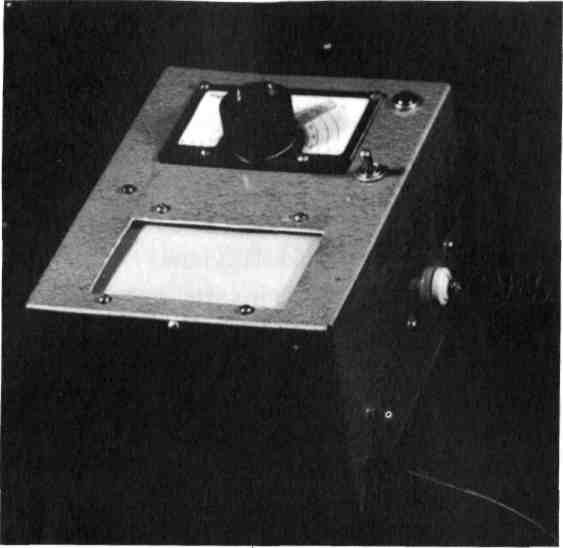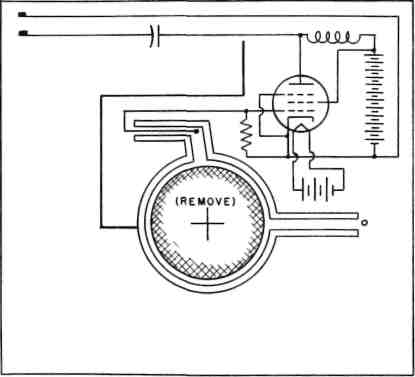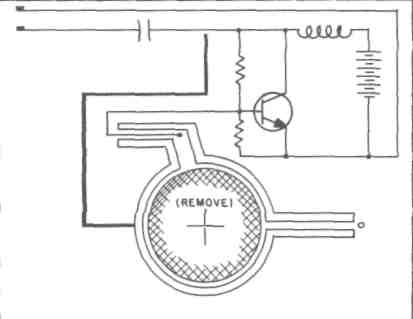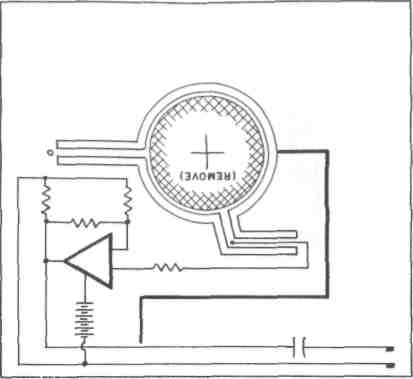
- •11701 South Belcher Road, Suite 123
- •Introduction
- •Introduction
- •Chapter one
- •Chapter two detector rods Basic Description:
- •Chapter three
- •Chapter four the energy wheel Basic Description:
- •Chapter five pendulums Basic Description:
- •Inside an inverted water tumbler as shown.
- •Chapter six
- •Basic Description:
- •Chapter seven
- •Chapter eight
- •Basic Description:
- •Integrated circuit amplifier board for the
- •Chapter nine
- •Chapter ten postscript
- •Bibliography
- •11701 South Belcher Road, #123
Chapter eight
THE SYMBOLIC HIERONYMOUS MACHINE
Basic Description:
This strange machine is strange indeed. It is a Hieronymous machine consisting entirely of symbols save for a few moving physical parts needed to rotate the prism, the sensor coil, and the tactile detector. It is typical of many inexplicable but operable devices made up of symbols representing physical objects. These symbols are arranged in the same relationship as the physical
143
Mind Machines You Can Build
devices in the original machine. It produces the same result as the non-symbolic machine with about the same degree of reliability and repeatability. Furthermore, it operates with no apparent input of energy as energy is presently understood in the physical sciences. However, it may not operate under any of the presently-known principles of physical or psychological sciences.
The symbolic Hieronymous machine consists of the standard pickup coil or sensor of the non-symbolic machine, the tactile detector plate, a means to rotate a symbolic prism to tune the device, and all other elements of the machine reduced to inked drawings on cardboard connected with symbolic electrical wires made of thread. It is enclosed in a standard electronics parts box. The model for use during experiments also contains an AC power cable and plug, a small transformer, a switch, and a pilot light, none of which are connected to any of the symbolic circuitry inside the box.
The device behaves essentially as the original non-symbolic Hieronymous machine does. Many people have tried it and have gotten results fully equivalent to the results obtained on the non-symbolic Hieronymous machine.
Historical Background:
When John W. Campbell, Jr. began working in 1955-1956 with the original Hieronymous machine described in Chapter Six, he discovered that it ceased to
144
The Symbolic Hieronymous Machine
work if a vacuum tube burned out - if the filament broke, if the glass or metal envelope broke, or if the tube somehow ceased to function effectively as an electronic device. He also discovered that it wouldn't work if one of the wires came un-soldered or broke.
But he accidentally discovered during an experimental run with a volunteer subject that the Hieronymous machine worked perfectly well even though he'd completely forgotten to plug it into the 120-volt AC wall socket. In other words, the Hieronymous machine would operate without any power supply at all!
Campbell wrote, "I can't defend, or even describe, the process by which I arrived at the hunch, 'These things depend upon relationship-as-a-thing-in-itself.'" Campbell then took that hunch as a postulate, did some deductive thinking, and carried out some physical equipment tests. If relationship only was involved, then the presence or absence of a power supply in the Hieronymous machine should make no difference because it wouldn't change the relationship of the parts. But a burned-out tube or a broken connection would make a difference; it would alter the relationship of the parts.
He went directly to the purest form of this postulate. He reasoned that the closer the experiment was to a pure symbol, the less objective reality there would be and the more nearly a perfectly pure relationship would exist. "The letter A scratched in the mud is a symbol; it has precisely the same symbolic properties as a letter A
145
Mind Machines You Can Build
made of reinforced concrete and standing forty feet high. The material object structure has zero significance; only the relationship pattern has meaning."
He built a Hieronymous machine leaving out most of the material objects of the system by substituting symbols which maintained the same relationship to one another. Because he was also a realist and felt that the mind-set of "impossible" or "possible" might strongly affect the initial results a subject experienced, he added the totally non-functional but equally totally misleading on-off switch and pilot light. Externally, therefore, the symbolic Hieronymous machine looked completely normal save for the unusual tactile detector which, on the basis of his previous experiments with the non-symbolic Hieronymous machine, he knew that people would accept.
His first subject was his young daughter who'd gotten results with the non-symbolic machine. She got a response with the symbolic machine and reported a "tacky feeling" at two points on the tuning dial. She was able to retune to the same dial readings, plus or minus two percent, on successive tries, even when her view of the dial was blocked and the vernier returned to the zero point before each trial run. After approximately a hundred additional subjects had tried it, Campbell confirmed that the percentage of subjects who got a reading was the same as with the non-symbolic machine - approximately 80%. Additional data: Children under the age of fifteen got consistently repeatable results while professional re-
146
The Symbolic Hieronymous Machine
search scientists almost invariably got a clean, 100% no-response record. Convinced mystics got wild responses all over the dial.
Once a subject had gotten a response, Campbell would open the machine and show them what was inside. The most common reaction was, "Why, there's nothing inside!" But nearly 90% of the subjects continued to get responses even when they knew that the inside of the box contained only symbolic components and that the pilot light and "on-off" switch had absolutely no function whatsoever.
Campbell published the full instructions on how to build a symbolic Hieronymous machine along with his results and hypotheses in the February 1957 issue of Astounding Science Fiction.
What was truly astounding was the resounding silence that followed and has been maintained ever since. No research laboratories have followed up on this discovery. Perhaps some amateur researchers have carried on, but their results have not seen general publication.
Author's Experience:
When I read the first Hieronymous Machine article in the June 1956 issue of Astounding Science Fiction magazine and built a non-symbolic Hieronymous machine, the results I got were interesting because the machine shouldn't have worked. Okay, I thought, the world is full of weird machines that we really don't
147
Mind Machines You Can Build
understand yet, and 1 was intimately familiar with a lot of them that went under the general title of rockets. But when I read the February 1957 issue with Campbell's article on the symbolic Hieronymous machine, that was too much for me. Remember, I was educated as a physicist and trained in the field as an engineer. The article was obviously a hoax. I immediately set out to prove that it was a hoax by building a symbolic Hieronymous machine myself. I carefully followed the instructions given in Campbell's article.
It didn't work on the first try. I was about to write it off when I decided that there was something wrong with the circuit. There was no provision for a filament heater power supply for the vacuum tube symbol. So I added a symbolic filament inside the symbolic tube and "wired" it symbolically to a symbolic filament battery.
I was then hugely surprised when my symbolic Hieronymous machine worked!
My wife Barbara could get no response from it. But about 80% of my scientific and engineering colleagues did at White Sands Proving Ground and at the New Mexico College of Agriculture and Mechanic Arts.
I kept the machine and still have it. I take it out from time to time to try it on a new and unsuspecting subject. I've encountered two fascinating and inexplicable problems: (a) every couple of years, I must re-ink the battery symbols because the symbolic batteries appear to go "dead," and (b) I have to re-ink the vacuum tube symbol every ten years to put a "new and fresh" tube
148
The Symbolic Hieronymous
Machine
Figure 8-1: The author's symbolic Hieronymous
machine built in 1956. It still works.
But why does it work in the first place?
in the system. My solid-state versions haven't been in operation long enough to have encountered any failures of the "circuit chips" which, if my computer is any typical example, will exhibit outstanding reliability and long life exemplary of solid-state electronic components in the real world.
149
Mind Machines You Can Build
Instructions for Fabrication:
The symbolic Hieronymous machine is easier to construct than one of the full-blown hardware types. However, hardware is required:
An aluminum or plastic electronics component box.
A National Velvet Vernier Dial of the sort used in the standard Hieronymous machine.
A 4-inch by 5-inch piece of polystyrene or lucite ("Plexiglas") plastic sheet for the tactile detector plate.
A pickup coil - this can be wound as several turns of #18 AWG solid wire to make a simple air-core coil.
A small triangular-shaped piece of clear plastic to serve as a symbolic prism.
Various and sundry mounting and assembly hardware - nuts and bolts, standoffs, insulators, etc.
If you wish to include the pilot light and "on-off' switch, the following additional materials will be needed: a single-pole single-throw toggle switch, a 12-volt power transformer, a 12-volt panel-mounted pilot light and bulb, and an AC line cord and plug, plus mounting hardware.
The symbolic circuitry can be inked onto white cardboard or Crescent No. 201 Illustration Board (or equivalent). The circuit board and the tactile detector's
150
The Symbolic Hieronymous Machine
coil can be cut out using a sharp modeling knife. Ordinary sewing thread may be used to connect the circuit board to the tactile detector coil board.
The precise size and shape of the symbolic components are not important. The material used in making the symbolic parts is not important. Workable models have been built from cardboard, plastic, vinyl tiles, sheet metal, and a host of other materials. Tiny pocket-sized machines have been built. The actual electronic circuits used don't seem to be important; a multi-staged transis-

Figure 8-2:
Symbolic Hieronymous machine's vacuum tube
amplifier circuit board. Drawing is full-sized for
author's machine, but size isn't important.
Following the drawing accurately from a
symbolic point of view seems to be critical.
151
Mind Machines You Can Build
tor amplifier seems to work as well as a single-transistor unit. The precise type of symbolic op-amp circuit is apparently irrelevant. The only important factor is the relationship between the components plus the fact that operable circuits must be used - if actual physical electronic circuits were built using actual hardware and the circuit diagrams used in the symbolic machine, the physical circuits would indeed work as amplifiers.
I have seen an operable symbolic Hieronymous machine inked on the back of a 2-inch square of bathroom tile with the slick fired-enamel surface of the tile serving as the tactile detector.

Figure 8-3: Symbolic Hieronymous machine's
transistorized amplifier circuit board for the
"modern" solid-state version.
152
The Symbolic Hieronymous
Machine
Figure 8-4: Symbolic Hieronymous machine's
